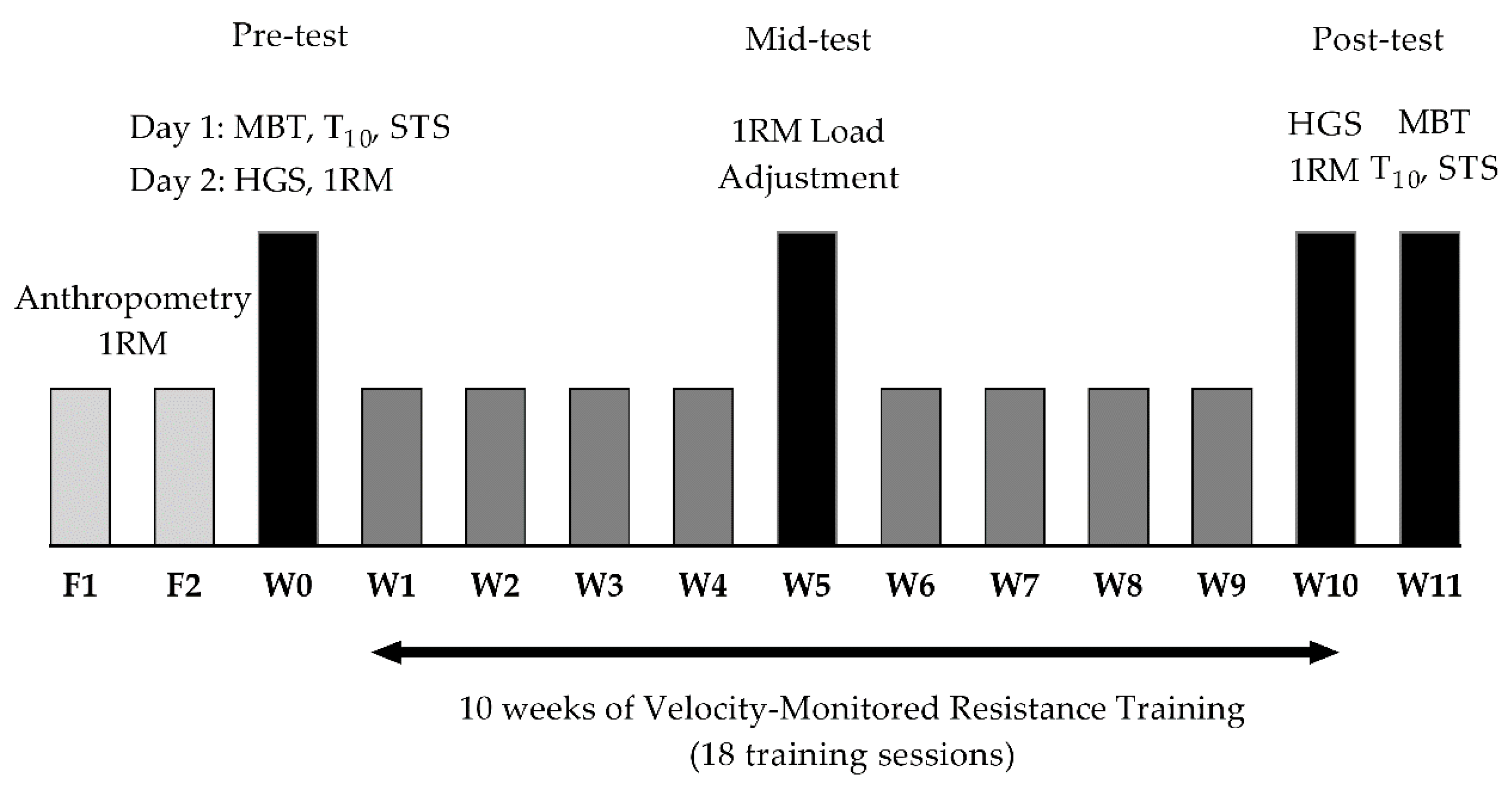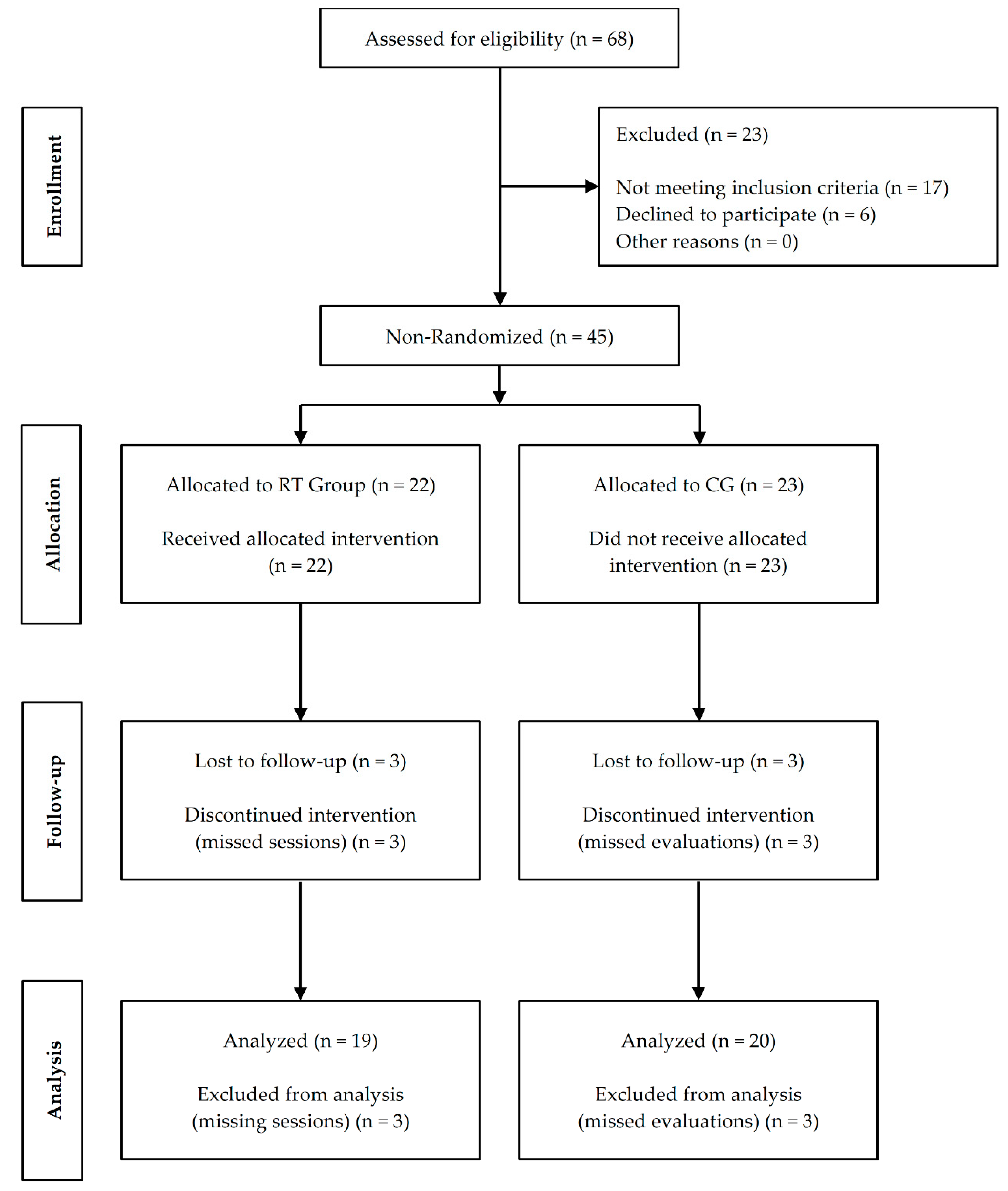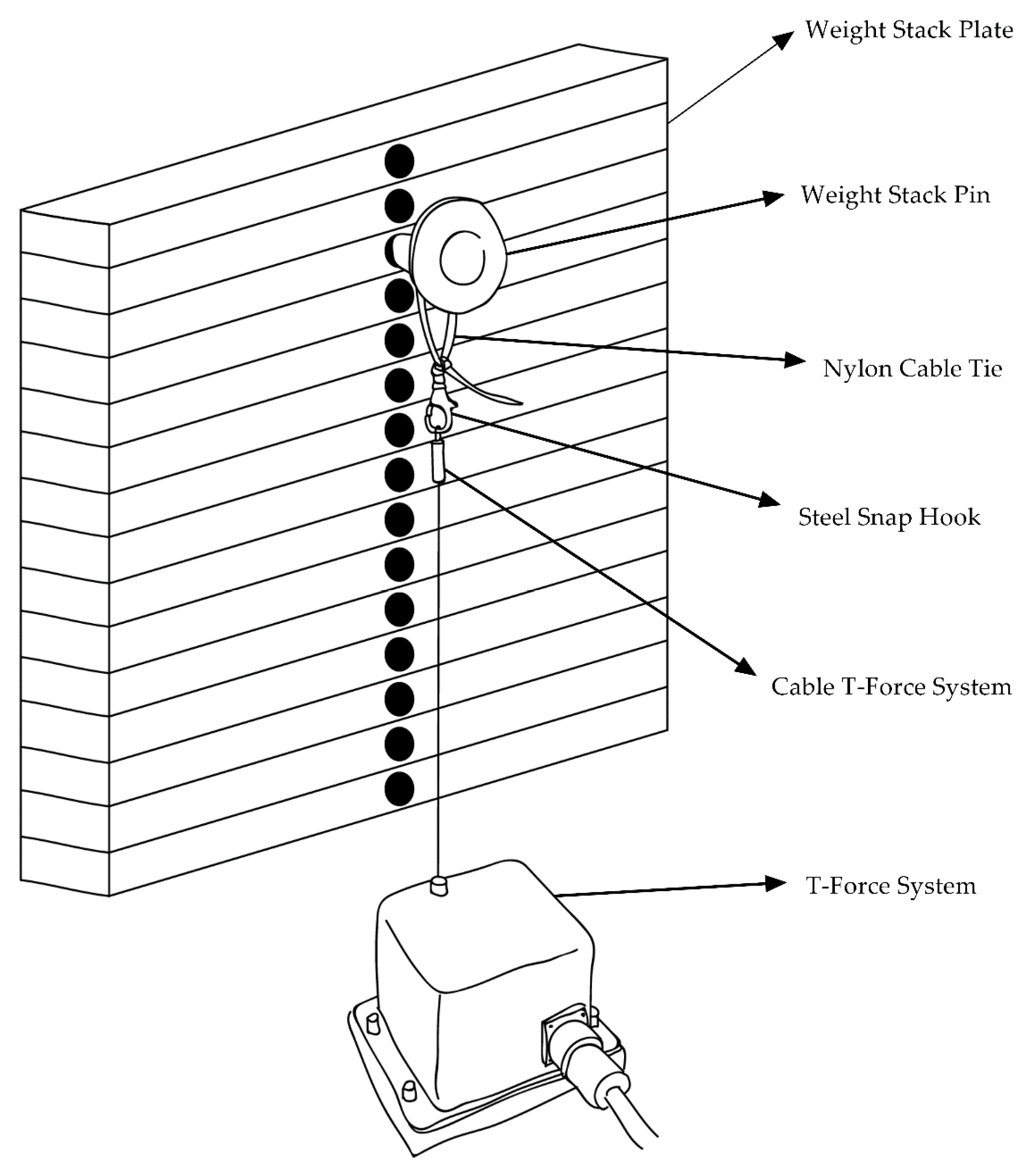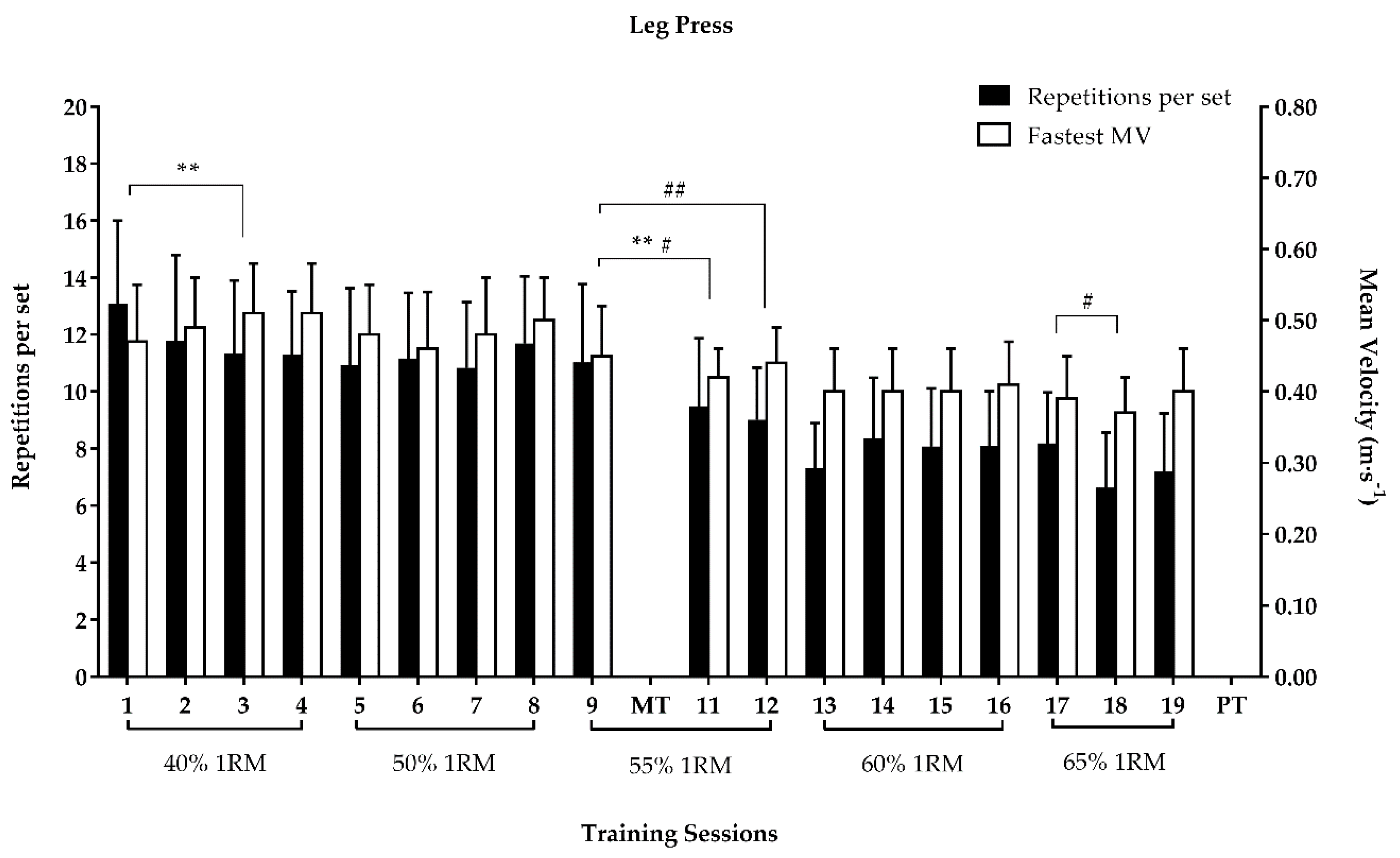Novel Resistance Training Approach to Monitoring the Volume in Older Adults: The Role of Movement Velocity
Abstract
1. Introduction
2. Materials and Methods
2.1. Study Design
2.2. Participants
2.3. Sample Size
2.4. Outcome Measures
2.4.1. One-Repetition Maximum Leg-Press and Chest-Press
2.4.2. Handgrip Strength
2.4.3. Seated Medicine Ball Throw
2.4.4. 10 m Walking Speed
2.4.5. Five-Repetition Sit-To-Stand
2.5. Resistance Training Program
2.6. Data Collection
2.7. Statistical Analysis
3. Results
4. Discussion
5. Conclusions
Author Contributions
Funding
Acknowledgments
Conflicts of Interest
References
- Valenzuela, P.L.; Castillo-García, A.; Morales Rojas, J.S.; Izquierdo, M.; Serra-Rexach, J.; Santos-Lozano, A.; Lucia, A. Physical Exercise in the Oldest Old. Compr. Physiol. 2019, 1281–1304. [Google Scholar] [CrossRef]
- Pahor, M.; Guralnik, J.M.; Ambrosius, W.T.; Blair, S.; Bonds, D.E.; Church, T.S.; Espeland, M.A.; Fielding, R.A.; Gill, T.M.; Groessl, E.J.; et al. Effect of Structured Physical Activity on Prevention of Major Mobility Disability in Older Adults: The LIFE Study Randomized Clinical Trial. JAMA 2014, 311, 2387–2396. [Google Scholar] [CrossRef] [PubMed]
- Yeung, S.S.Y.; Reijnierse, E.M.; Pham, V.K.; Trappenburg, M.C.; Lim, W.K.; Meskers, C.G.M.; Maier, A.B. Sarcopenia and its association with falls and fractures in older adults: A systematic review and meta-analysis. J. Cachexia Sarcopenia Muscle 2019, 10, 485–500. [Google Scholar] [CrossRef] [PubMed]
- Aagaard, P.; Suetta, C.; Caserotti, P.; Magnusson, S.P.; Kjær, M. Role of the nervous system in sarcopenia and muscle atrophy with aging: Strength training as a countermeasure. Scand. J. Med. Sci. Sports 2010, 20, 49–64. [Google Scholar] [CrossRef]
- Fragala, M.S.; Cadore, E.L.; Dorgo, S.; Izquierdo, M.; Kraemer, W.J.; Peterson, M.D.; Ryan, E.D. Resistance Training for Older Adults: Position Statement from the National Strength and Conditioning Association. J. Strength Cond. Res. 2019, 33, 2019–2052. [Google Scholar] [CrossRef]
- Marques, M.C.; Izquierdo, M.; Pereira, A. High-Speed Resistance Training in Elderly People: A New Approach toward Counteracting Age-Related Functional Capacity Loss. Strength Cond. J. 2013, 35, 23–29. [Google Scholar] [CrossRef]
- Pereira, A.; Izquierdo, M.; Silva, A.J.; Costa, A.M.; Bastos, E.; González-Badillo, J.J.; Marques, M.C. Effects of high-speed power training on functional capacity and muscle performance in older women. Exp. Gerontol. 2012, 47, 250–255. [Google Scholar] [CrossRef]
- Ramírez-Campillo, R.; Castillo, A.; de la Fuente, C.I.; Campos-Jara, C.; Andrade, D.C.; Álvarez, C.; Martínez, C.; Castro-Sepúlveda, M.; Pereira, A.; Marques, M.C.; et al. High-speed resistance training is more effective than low-speed resistance training to increase functional capacity and muscle performance in older women. Exp. Gerontol. 2014, 58, 51–57. [Google Scholar] [CrossRef]
- Ramírez-Campillo, R.; Martínez, C.; de La Fuente, C.I.; Cadore, E.L.; Marques, M.C.; Nakamura, F.Y.; Loturco, I.; Caniuqueo, A.; Cañas, R.; Izquierdo, M.; et al. High-Speed Resistance Training in Older Women: The Role of Supervision. J. Aging Phys. Act. 2017, 25, 1–9. [Google Scholar] [CrossRef]
- Bottaro, M.; Machado, S.N.; Nogueira, W.; Scales, R.; Veloso, J. Effect of high versus low-velocity resistance training on muscular fitness and functional performance in older men. Eur. J. Appl. Physiol. 2007, 99, 257–264. [Google Scholar] [CrossRef]
- Nogueira, W.; Gentil, P.; Mello, S.N.M.; Oliveira, R.J.; Bezerra, A.J.C.; Bottaro, M. Effects of Power Training on Muscle Thickness of Older Men. Int. J. Sports Med. 2009, 30, 200–204. [Google Scholar] [CrossRef] [PubMed]
- Cannon, J.; Marino, F.E. Early-phase neuromuscular adaptations to high- and low-volume resistance training in untrained young and older women. J. Sports Sci. 2010, 28, 1505–1514. [Google Scholar] [CrossRef] [PubMed]
- Radaelli, R.; Botton, C.E.; Wilhelm, E.N.; Bottaro, M.; Brown, L.E.; Lacerda, F.; Gaya, A.; Moraes, K.; Peruzzolo, A.; Pinto, R.S. Time course of low- and high-volume strength training on neuromuscular adaptations and muscle quality in older women. Age 2014, 36, 881–892. [Google Scholar] [CrossRef] [PubMed]
- Galvão, D.A.; Taaffe, D.R. Resistance Exercise Dosage in Older Adults: Single-versus Multiset Effects on Physical Performance and Body Composition. J. Am. Geriatr. Soc. 2005, 53, 2090–2097. [Google Scholar] [CrossRef] [PubMed]
- da Silva, L.X.N.; Teodoro, J.L.; Menger, E.; Lopez, P.; Grazioli, R.; Farinha, J.; Moraes, K.; Bottaro, M.; Pinto, R.S.; Izquierdo, M.; et al. Repetitions to failure versus not to failure during concurrent training in healthy elderly men: A randomized clinical trial. Exp. Gerontol. 2018, 108, 18–27. [Google Scholar] [CrossRef]
- Barbalho, M.d.S.M.; Gentil, P.; Izquierdo, M.; Fisher, J.; Steele, J.; Raiol, R.d.A. There are no no-responders to low or high resistance training volumes among older women. Exp. Gerontol. 2017, 99, 18–26. [Google Scholar] [CrossRef]
- Marques, D.L.; Neiva, H.P.; Faíl, L.B.; Gil, M.H.; Marques, M.C. Acute effects of low and high-volume resistance training on hemodynamic, metabolic and neuromuscular parameters in older adults. Exp. Gerontol. 2019, 125, 110685. [Google Scholar] [CrossRef]
- Tajra, V.; Vieira, D.C.; Tibana, R.A.; Teixeira, T.G.; Silva, A.O.; Farias, D.L.; Nascimento Dda, C.; de Sousa, N.M.; Willardson, J.; Prestes, J. Different acute cardiovascular stress in response to resistance exercise leading to failure versus not to failure in elderly women with and without hypertension—A pilot study. Clin. Physiol. Funct. Imaging 2015, 35, 127–133. [Google Scholar] [CrossRef]
- Vale, A.F.; Carneiro, J.A.; Jardim, P.C.V.; Jardim, T.V.; Steele, J.; Fisher, J.P.; Gentil, P. Acute effects of different resistance training loads on cardiac autonomic modulation in hypertensive postmenopausal women. J. Transl. Med. 2018, 16, 240. [Google Scholar] [CrossRef]
- Sánchez-Medina, L.; González-Badillo, J.J. Velocity loss as an indicator of neuromuscular fatigue during resistance training. Med. Sci. Sports Exerc. 2011, 43, 1725–1734. [Google Scholar] [CrossRef]
- González-Badillo, J.J.; Yañez-Garcia, J.M.; Mora-Custodio, R.; Rodríguez-Rosell, D. Velocity Loss as a Variable for Monitoring Resistance Exercise. Int. J. Sports Med. 2017, 38, 217–225. [Google Scholar] [CrossRef]
- Pareja-Blanco, F.; Rodríguez-Rosell, D.; Sánchez-Medina, L.; Sanchis-Moysi, J.; Dorado, C.; Mora-Custodio, R.; Yáñez-García, J.M.; Morales-Alamo, D.; Pérez-Suárez, I.; Calbet, J.A.L.; et al. Effects of velocity loss during resistance training on athletic performance, strength gains and muscle adaptations. Scand. J. Med. Sci. Sports 2017, 27, 724–735. [Google Scholar] [CrossRef]
- Rodríguez-Rosell, D.; Yáñez-García, J.M.; Mora-Custodio, R.; Pareja-Blanco, F.; Ravelo-García, A.G.; Ribas-Serna, J.; González-Badillo, J.J.; Yanez-Garcia, J.M.; Mora-Custodio, R.; Pareja-Blanco, F.; et al. Velocity-based resistance training: Impact of velocity loss in the set on neuromuscular performance and hormonal response. Appl. Physiol. Nutr. Metab. 2020. [Google Scholar] [CrossRef] [PubMed]
- Rodríguez-Rosell, D.; Yanez-Garcia, J.M.; Torres-Torrelo, J.; Mora-Custodio, R.; Marques, M.C.; González-Badillo, J.J. Effort Index as a Novel Variable for Monitoring the Level of Effort during Resistance Exercises. J. Strength Cond. Res. 2018, 32, 2139–2153. [Google Scholar] [CrossRef]
- Gentil, P.; Steele, J.; Fisher, J. Why intensity is not a bad word—Benefits and practical aspects of high effort resistance training to the older. Clin. Nutr. 2017, 36, 1454–1455. [Google Scholar] [CrossRef] [PubMed][Green Version]
- Häkkinen, K.; Kraemer, W.J.; Newton, R.U.; Alen, M. Changes in electromyographic activity, muscle fibre and force production characteristics during heavy resistance/power strength training in middle-aged and older men and women. Acta Physiol. Scand. 2001, 171, 51–62. [Google Scholar] [CrossRef]
- Kamen, G.; Knight, C.A. Training-Related Adaptations in Motor Unit Discharge Rate in Young and Older Adults. J. Gerontol. Ser. A Biol. Sci. Med. Sci. 2004, 59, 1334–1338. [Google Scholar] [CrossRef]
- Van Roie, E.; Delecluse, C.; Coudyzer, W.; Boonen, S.; Bautmans, I. Strength training at high versus low external resistance in older adults: Effects on muscle volume, muscle strength, and force-velocity characteristics. Exp. Gerontol. 2013, 48, 1351–1361. [Google Scholar] [CrossRef] [PubMed]
- Arifin, W.N. Sample Size Calculator (Version 2.0) [Spreadsheet File]. Available online: http://wnarifin.github.io (accessed on 20 July 2020).
- Alcazar, J.; Losa-Reyna, J.; Rodriguez-Lopez, C.; Alfaro-Acha, A.; Rodriguez-Mañas, L.; Ara, I.; García-García, F.J.; Alegre, L.M.; Rodriguez-Manas, L.; Ara, I.; et al. The sit-to-stand muscle power test: An easy, inexpensive and portable procedure to assess muscle power in older people. Exp. Gerontol. 2018, 112, 38–43. [Google Scholar] [CrossRef]
- González-Badillo, J.J.; Sánchez-Medina, L. Movement Velocity as a Measure of Loading Intensity in Resistance Training. Int. J. Sports Med. 2010, 31, 347–352. [Google Scholar] [CrossRef]
- Courel-Ibáñez, J.; Martínez-Cava, A.; Morán-Navarro, R.; Escribano-Peñas, P.; Chavarren-Cabrero, J.; González-Badillo, J.J.; Pallarés, J.G. Reproducibility and Repeatability of Five Different Technologies for Bar Velocity Measurement in Resistance Training. Ann. Biomed. Eng. 2019. [Google Scholar] [CrossRef]
- Koo, T.K.; Li, M.Y. A Guideline of Selecting and Reporting Intraclass Correlation Coefficients for Reliability Research. J. Chiropr. Med. 2016, 15, 155–163. [Google Scholar] [CrossRef] [PubMed]
- Hedges, L.V.; Olkin, I. Statistical Methods for Meta-Analysis; Academic Press: San Diego, CA, USA, 1985; ISBN 978-0-08-057065-5. [Google Scholar]
- Hopkins, W.G.; Marshall, S.W.; Batterham, A.M.; Hanin, J. Progressive statistics for studies in sports medicine and exercise science. Med. Sci. Sports Exerc. 2009, 41, 3–12. [Google Scholar] [CrossRef]
- Balachandran, A.; Krawczyk, S.N.; Potiaumpai, M.; Signorile, J.F. High-speed circuit training vs hypertrophy training to improve physical function in sarcopenic obese adults: A randomized controlled trial. Exp. Gerontol. 2014, 60, 64–71. [Google Scholar] [CrossRef] [PubMed]
- Henwood, T.R.; Taaffe, D.R. Short-term resistance training and the older adult: The effect of varied programmes for the enhancement of muscle strength and functional performance. Clin. Physiol. Funct. Imaging 2006, 26, 305–313. [Google Scholar] [CrossRef] [PubMed]
- Marsh, A.P.; Miller, M.E.; Rejeski, W.J.; Hutton, S.L.; Kritchevsky, S.B. Lower extremity muscle function after strength or power training in older adults. J. Aging Phys. Act. 2009, 17, 416–443. [Google Scholar] [CrossRef]
- Miszko, T.A.; Cress, M.E.; Slade, J.M.; Covey, C.J.; Agrawal, S.K.; Doerr, C.E. Effect of Strength and Power Training on Physical Function in Community-Dwelling Older Adults. J. Gerontol. Ser. A Biol. Sci. Med. Sci. 2003, 58, M171–M175. [Google Scholar] [CrossRef] [PubMed]
- Ramírez-Campillo, R.; Alvarez, C.; Garcia-Hermoso, A.; Celis-Morales, C.; Ramirez-Velez, R.; Gentil, P.; Izquierdo, M. High-speed resistance training in elderly women: Effects of cluster training sets on functional performance and quality of life. Exp. Gerontol. 2018, 110, 216–222. [Google Scholar] [CrossRef]
- Richardson, D.L.; Duncan, M.J.; Jimenez, A.; Juris, P.M.; Clarke, N.D. Effects of movement velocity and training frequency of resistance exercise on functional performance in older adults: A randomised controlled trial. Eur. J. Sport Sci. 2019, 19, 234–246. [Google Scholar] [CrossRef]
- Richardson, D.L.; Duncan, M.J.; Jimenez, A.; Juris, P.M.; Clarke, N.D. Affective responses to supervised 10-week programs of resistance exercise in older adults. J. Sport Health Sci. 2019. [Google Scholar] [CrossRef]
- Wang, E.; Nyberg, S.K.; Hoff, J.; Zhao, J.; Leivseth, G.; Tørhaug, T.; Husby, O.S.; Helgerud, J.; Richardson, R.S. Impact of maximal strength training on work efficiency and muscle fiber type in the elderly: Implications for physical function and fall prevention. Exp. Gerontol. 2017, 91, 64–71. [Google Scholar] [CrossRef] [PubMed]
- Pinto, R.S.; Correa, C.S.; Radaelli, R.; Cadore, E.L.; Brown, L.E.; Bottaro, M. Short-term strength training improves muscle quality and functional capacity of elderly women. Age 2014, 36, 365–372. [Google Scholar] [CrossRef] [PubMed]
- Tieland, M.; Verdijk, L.B.; de Groot, L.C.P.G.M.; van Loon, L.J.C. Handgrip Strength Does Not Represent an Appropriate Measure to Evaluate Changes in Muscle Strength During an Exercise Intervention Program in Frail Older People. Int. J. Sport Nutr. Exerc. Metab. 2015, 25, 27. [Google Scholar] [CrossRef] [PubMed]
- Dias, R.K.N.; Penna, E.M.; Noronha, A.S.N.; de Azevedo, A.B.C.; Barbalho, M.; Gentil, P.V.; Coswig, V.S. Cluster-sets resistance training induce similar functional and strength improvements than the traditional method in postmenopausal and elderly women. Exp. Gerontol. 2020, 138, 111011. [Google Scholar] [CrossRef]
- Balachandran, A.T.; Gandia, K.; Jacobs, K.A.; Streiner, D.L.; Eltoukhy, M.; Signorile, J.F. Power training using pneumatic machines vs. plate-loaded machines to improve muscle power in older adults. Exp. Gerontol. 2017, 98, 134–142. [Google Scholar] [CrossRef]
- Tiggemann, C.L.; Dias, C.P.; Radaelli, R.; Massa, J.C.; Bortoluzzi, R.; Schoenell, M.C.W.; Noll, M.; Alberton, C.L.; Kruel, L.F.M. Effect of traditional resistance and power training using rated perceived exertion for enhancement of muscle strength, power, and functional performance. Age (Omaha) 2016, 38, 42. [Google Scholar] [CrossRef]





| Variable | RT Group (12 Women; 7 Men) | CG (14 Women; 6 Men) | p-Value |
|---|---|---|---|
| Age (years) | 78.6 ± 7.6 (range: 69 to 92) | 79.0 ± 6.0 (range: 70 to 89) | 0.85 |
| Body mass (kg) | 70.4 ± 14.3 | 70.3 ± 12.6 | 0.98 |
| Height (m) | 1.55 ± 0.11 | 1.57 ± 0.09 | 0.68 |
| BMI (kg/m2) | 29.3 ± 5.4 | 28.6 ± 4.0 | 0.66 |
| MMSE | 24.3 ± 2.3 | 24.5 ± 1.8 | 0.78 |
| Week 1 | Week 2 | Week 3 | Week 4 | Week 5 | ||||||
|---|---|---|---|---|---|---|---|---|---|---|
| Exercises | TS1 | TS2 | TS3 | TS4 | TS5 | TS6 | TS7 | TS8 | TS9 | TS10 |
| LP & CP (S × VL [%]) | 2 × 20% | 2 × 20% | 3 × 20% | 3 × 20% | 2 × 20% | 2 × 20% | 3 × 20% | 3 × 20% | 2 × 20% | 1RM Mid-test Load Adjustment |
| 1RM (%) | 40% | 40% | 40% | 40% | 50% | 50% | 50% | 50% | 55% | |
| Chair-Squat (S × R × kg) | 1 × 10 × 3 | 1 × 10 × 3 | 2 × 10 × 3 | 2 × 10 × 3 | 2 × 10 × 3 | 2 × 10 × 3 | 3 × 10 × 3 | 3 × 10 × 3 | 3 × 10 × 3 | |
| MBT (S × R × kg) | 1 × 10 × 1 | 1 × 10 × 1 | 2 × 10 × 1 | 2 × 10 × 1 | 2 × 10 × 1 | 2 × 10 × 1 | 3 × 10 × 1 | 3 × 10 × 1 | 3 × 10 × 1 | |
| Week 6 | Week 7 | Week 8 | Week 9 | Week 10 | ||||||
| Exercises | TS11 | TS12 | TS13 | TS14 | TS15 | TS16 | TS17 | TS18 | TS19 | TS20 |
| LP & CP (S × VL [%]) | 2 × 20% | 2 × 20% | 3 × 20% | 3 × 20% | 2 × 20% | 2 × 20% | 3 × 20% | 3 × 20% | 2 × 20% | 1RM Post-test |
| 1RM (%) | 55% | 55% | 60% | 60% | 60% | 60% | 65% | 65% | 65% | |
| Chair-Squat (S × R × kg) | 4 × 8 × 3 | 4 × 8 × 3 | 4 × 8 × 3 | 4 × 8 × 3 | 4 × 8 × 3 | 4 × 8 × 3 | 4 × 8 × 3 | 4 × 8 × 3 | 2 × 8 × 3 | |
| MBT (S × R × kg) | 4 × 8 × 1 | 4 × 8 × 1 | 4 × 8 × 1 | 4 × 8 × 1 | 4 × 8 × 1 | 4 × 8 × 1 | 4 × 8 × 1 | 4 × 8 × 1 | 2 × 8 × 1 | |
| RT Group | CG | RT vs. CG | ||||||||
|---|---|---|---|---|---|---|---|---|---|---|
| Variable | Pre-Test | Post-Test | Δ (90% CI) | ES | Pre-Test | Post-Test | Δ (90% CI) | ES | p | ES |
| 1RM LP (kg) | 74.79 ± 23.12 | 85.00 ± 22.79 *** | 15.07 (11.77 to 18.37) | 0.43 | 67.65 ± 20.5 | 67.15 ± 18.42 | −0.26 (−1.81 to 1.29) | −0.02 | <0.001 | 0.85 |
| 1RM CP (kg) | 31.54 ± 13.15 | 39.26 ± 12.48 *** | 31.35 (21.05 to 41.66) | 0.58 | 30.10 ± 9.40 | 29.75 ± 8.58 | −0.24 (−2.84 to 2.37) | −0.04 | <0.001 | 0.87 |
| HGS (kg) | 25.20 ± 8.50 | 25.07 ± 8.01 | −0.08 (−2.34 to 2.18) | −0.02 | 25.55 ± 7.19 | 25.15 ± 6.90 | −1.08 (−3.74 to 1.59) | −0.05 | >0.05 | −0.01 |
| MBT-1kg (m) | 3.01 ± 0.60 | 3.24 ± 0.62 *** | 8.09 (4.80 to 11.38) | 0.37 | 2.91 ± 0.59 | 2.87 ± 0.64 | −1.59 (−3.67 to 0.50) | −0.06 | <0.001 | 0.57 |
| MBT-3kg (m) | 2.26 ± 0.43 | 2.31 ± 0.38 | 2.99 (0.04 to 5.94) | 0.12 | 2.13 ± 0.37 | 2.17 ± 0.43 | 1.74 (−1.23 to 4.70) | 0.10 | >0.05 | 0.33 |
| T10 (s) | 6.17 ± 0.82 | 6.05 ± 0.94 | −1.77 (−5.94 to 2.40) | −0.14 | 6.57 ± 0.99 | 6.69 ± 0.91 | 2.00 (0.46 to 3.55) | 0.12 | >0.05 | −0.68 |
| T10-MV (m·s−1) | 1.65 ± 0.22 | 1.69 ± 0.25 | 3.04 (−1.40 to 7.47) | 0.18 | 1.55 ± 0.22 | 1.52 ± 0.20 * | −1.81 (−3.24 to −0.38) | −0.15 | >0.05 | 0.74 |
| STS (s) | 9.70 ± 1.22 | 8.56 ± 1.39 *** | −11.72 (−14.73 to −8.71) | −0.84 | 10.36 ± 1.10 | 10.38 ± 1.01 | 0.38 (−0.99 to 1.75) | 0.02 | <0.001 | −1.48 |
| STS-MV (m·s−1) | 0.29 ± 0.07 | 0.33 ± 0.08 *** | 13.93 (9.89 to 17.97) | 0.51 | 0.28 ± 0.05 | 0.27 ± 0.05 | −0.24 (−1.61 to 1.13) | −0.01 | <0.001 | 0.78 |
| STS-MP (W) | 183.54 ± 73.66 | 211.12 ± 87.37 *** | 14.86 (10.61 to 19.12) | 0.33 | 173.93 ± 55.72 | 173.27 ± 56.80 | −0.47 (−1.87 to 0.92) | −0.01 | <0.001 | 0.51 |
| Leg-Press | Chest-Press | p | Effect Size | ||
|---|---|---|---|---|---|
| Variable | Mean (95% CI) | Mean (95% CI) | Between | g | Magnitude |
| Total repetitions | 437.63 (407.89 to 467.37) | 296.37 (260.89 to 331.84) | <0.001 | 1.90 | Large |
| Repetitions per set | 9.75 (8.44 to 11.06) | 6.58 (5.48 to 7.68) | <0.001 | 1.15 | Moderate |
| Fastest MV (m·s−1) | 0.44 (0.41 to 0.48) | 0.37 (0.33 to 0.40) | <0.001 | 0.97 | Moderate |
| Average MV (m·s−1) | 0.38 (0.35 to 0.41) a | 0.31 (0.28 to 0.35) b | <0.001 | 0.98 | Moderate |
| Velocity loss (%) | 22.87 (22.16 to 23.59) | 23.77 (22.80 to 24.73) | <0.001 | −0.46 | Small |
Publisher’s Note: MDPI stays neutral with regard to jurisdictional claims in published maps and institutional affiliations. |
© 2020 by the authors. Licensee MDPI, Basel, Switzerland. This article is an open access article distributed under the terms and conditions of the Creative Commons Attribution (CC BY) license (http://creativecommons.org/licenses/by/4.0/).
Share and Cite
Marques, D.L.; Neiva, H.P.; Marinho, D.A.; Marques, M.C. Novel Resistance Training Approach to Monitoring the Volume in Older Adults: The Role of Movement Velocity. Int. J. Environ. Res. Public Health 2020, 17, 7557. https://doi.org/10.3390/ijerph17207557
Marques DL, Neiva HP, Marinho DA, Marques MC. Novel Resistance Training Approach to Monitoring the Volume in Older Adults: The Role of Movement Velocity. International Journal of Environmental Research and Public Health. 2020; 17(20):7557. https://doi.org/10.3390/ijerph17207557
Chicago/Turabian StyleMarques, Diogo L., Henrique P. Neiva, Daniel A. Marinho, and Mário C. Marques. 2020. "Novel Resistance Training Approach to Monitoring the Volume in Older Adults: The Role of Movement Velocity" International Journal of Environmental Research and Public Health 17, no. 20: 7557. https://doi.org/10.3390/ijerph17207557
APA StyleMarques, D. L., Neiva, H. P., Marinho, D. A., & Marques, M. C. (2020). Novel Resistance Training Approach to Monitoring the Volume in Older Adults: The Role of Movement Velocity. International Journal of Environmental Research and Public Health, 17(20), 7557. https://doi.org/10.3390/ijerph17207557








